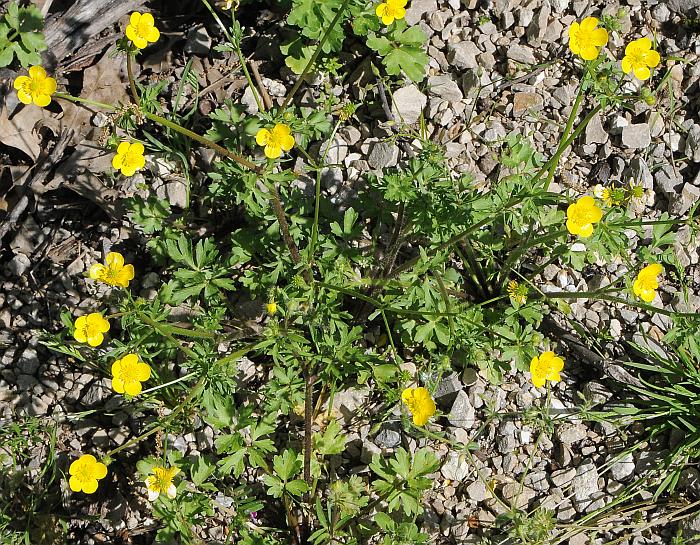Ranunculus sardous Crantz
Hairy Buttercup

Introduced
CC = *
CW = 3
MOC = 28
© SRTurner
Ranunculus sardous CrantzHairy Buttercup | |
 |
Introduced CC = * CW = 3 MOC = 28 |
© SRTurner |
|
Family - Ranunculaceae Habit - Annual forb with fibrous, non-tuberous roots. Stems - Ascending to erect, to 50 cm, not rooting at lower nodes, usually densely hairy with spreading hairs, lacking bulbils, the base not bulbous.
Leaves - Basal and alternate, deeply lobed or compound, usually hairy. Basal leaves usually present at flowering, long-petiolate, the blade 1-7 cm long, 1-6 cm wide, ovate to heart-shaped, usually compound (rarely only deeply divided), with 3 leaflets (or lobes), the base rounded to cordate, the terminal leaflet often short-stalked, the primary leaflets (or lobes) usually again 2- or 3-lobed, the segments oblong to obovate or rhombic, the margins otherwise coarsely toothed, the teeth mostly rounded to bluntly pointed at their tips. Stem leaves mostly short-petiolate to sessile, progressively reduced toward the stem tip, the blade progressively deeply 3-parted into narrower, less divided and toothed, more sharply pointed segments, those of the uppermost leaves linear to narrowly oblong-oblanceolate.
Inflorescences - Open panicles. Flowers - Sepals 5, 3-6 mm long, reflexed from 1-3 mm above the base along a well-defined transverse fold, more or less plane (the apical portion sometimes appearing somewhat folded longitudinally). Petals 5, 7-10 mm long, 4-8 mm wide, obovate to broadly oblong-obovate, longer than the sepals, glossy yellow. Style present.
Fruits - Head of achenes 5-8 mm long at maturity, globose to ovoid, the receptacle hairy. Achenes 2-3 mm long, the dorsal margin keeled and narrowly winged, the wall thick, usually pebbled or with minute papillae, occasionally smooth, glabrous, the beak 0.4-0.7 mm long, flattened, oblong to triangular, curved.
Flowering - April - June. Habitat - Pastures, crop fields and other open disturbed areas, sloughs, pond margins, forest openings. Origin - Native to Eurasia. Lookalikes - Several other species of Ranunculus; especially R. hispidus and R. fascicularis. Other info. - Although the accepted common name for this species is "hairy buttercup," it could as easily be called "pasture buttercup." In areas of Missouri where it occurs, it can form enormous populations capable of turning entire fields bright yellow. At the time of Steyermark's publication in 1963, this introduced plant was known from Missouri only from a single historical specimen from St. Louis County. Since then it has spread dramatically in southern regions of the state. It is also found in several states to the south and east of Missouri. The densest populations are found in highly disturbed habitats. Cattle avoid grazing the plant, enabling its rampant spread in pastures. Photographs taken at Otter Slough Conservation Area, Stoddard County, MO, 4-22-2019 (SRTurner). |